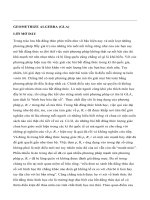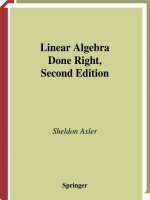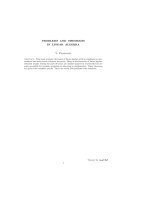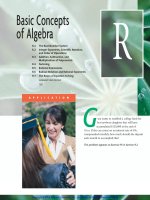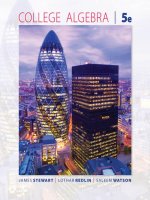Aufmann college algebra trigonometry 7th txtbk
Bạn đang xem bản rút gọn của tài liệu. Xem và tải ngay bản đầy đủ của tài liệu tại đây (18.3 MB, 1,077 trang )
www.elsolucionario.net
Motivating Features to Help You Succeed!
Your success in college algebra and trigonometry is important to us. To guide you to that
success, we have created a textbook with features that promote learning and support various
learning styles. These features are highlighted below. We encourage you to examine these
features and use them to successfully complete this course.
Prepare for This Section
These exercises test your understanding of
prerequisite skills and concepts that were
covered earlier in the text. Mastery of these
concepts is required for success in the
following section.
Motivating Applications
Large selections of contemporary
applications from many different disciplines
demonstrate the utility of mathematics.
Engaging Examples
Examples are designed to
capture your attention and help
you master important concepts.
Annotated Examples
Step-by-step solutions are
provided for each example.
Try Exercises
A reference to an exercise follows each
worked example. This exercise provides
you the opportunity to test your
understanding by working an exercise
similar to the worked example.
www.elsolucionario.net
Solutions to Try Exercises
The complete solutions to the Try
Exercises can be found in the Solutions
to the Try Exercises appendix, starting
page S1.
Visualize the Solution
When appropriate, both algebraic
and graphical solutions are
provided to help visualize the
mathematics of the example and
to create a link between the two.
Mid-Chapter Quizzes
These quizzes will help you assess your
understanding of the concepts studied
earlier in the chapter. They provide a
mini-review of the chapter material.
Chapter Test Prep
This is a summary of the major concepts
discussed in the chapter and will help you
prepare for the chapter test. For each
concept, there is a reference to a worked
example illustrating how the concept is
used and at least one exercise in the
chapter review relating to that concept.
www.elsolucionario.net
This page intentionally left blank
www.elsolucionario.net
COLLEGE ALGEBRA
AND TRIGONOMETRY
www.elsolucionario.net
This page intentionally left blank
www.elsolucionario.net
COLLEGE ALGEBRA
AND TRIGONOMETRY
Chad Ehlers/Getty Images
SEVENTH
EDITION
Richard N. Aufmann
Vernon C. Barker
Richard D. Nation
Australia • Brazil • Japan • Korea • Mexico • Singapore • Spain • United Kingdom • United States
www.elsolucionario.net
College Algebra and Trigonometry,
Seventh Edition
Richard N. Aufmann, Vernon C. Barker,
Richard D. Nation
Acquisitions Editor: Gary Whalen
Senior Developmental Editor: Carolyn Crockett
Assistant Editor: Stefanie Beeck
© 2011, 2008 Brooks/Cole, Cengage Learning
ALL RIGHTS RESERVED. No part of this work covered by the copyright herein may
be reproduced, transmitted, stored, or used in any form or by any means, graphic,
electronic, or mechanical, including but not limited to photocopying, recording,
scanning, digitizing, taping, Web distribution, information networks, or information
storage and retrieval systems, except as permitted under Section 107 or 108 of the
1976 United States Copyright Act, without the prior written permission of the
publisher.
Editorial Assistant: Guanglei Zhang
Associate Media Editor: Lynh Pham
Marketing Manager: Myriah Fitzgibbon
Marketing Assistant: Angela Kim
Marketing Communications
Manager: Katy Malatesta
Content Project Manager: Jennifer Risden
For product information and technology assistance, contact us at
Cengage Learning Customer & Sales Support, 1-800-354-9706.
For permission to use material from this text or product, submit all
requests online at www.cengage.com/permissions.
Further permissions questions can be e-mailed to
Creative Director: Rob Hugel
Library of Congress Control Number: 2009938510
Art Director: Vernon Boes
ISBN-13: 978-1-4390-4860-3
Print Buyer: Karen Hunt
ISBN-10: 1-4390-4860-6
Rights Acquisitions Account Manager,
Text: Roberta Broyer
Rights Acquisitions Account Manager,
Image: Don Schlotman
Production Service: Graphic World Inc.
Brooks/Cole
20 Davis Drive
Belmont, CA 94002-3098
USA
Text Designer: Diane Beasley
Photo Researcher: PrepressPMG
Copy Editor: Graphic World Inc.
Illustrators: Network Graphics; Macmillan
Publishing Solutions
Cover Designer: Lisa Henry
Cengage Learning is a leading provider of customized learning solutions with office
locations around the globe, including Singapore, the United Kingdom, Australia,
Mexico, Brazil, and Japan. Locate your local office at www.cengage.com/global.
Cengage Learning products are represented in Canada by Nelson
Education, Ltd.
Cover Image: Chad Ehlers/Getty Images
Compositor: MPS Limited, A Macmillan
Company
To learn more about Brooks/Cole, visit www.cengage.com/brookscole
Purchase any of our products at your local college store or at our
preferred online store www.ichapters.com
Printed in the United States of America
1 2 3 4 5 6 7 13 12 11 10 09
www.elsolucionario.net
CONTENTS
CHAPTER P
Preliminary Concepts
P.1
P.2
P.3
P.4
P.5
P.6
1
The Real Number System 2
Integer and Rational Number Exponents 17
Polynomials 32
Mid-Chapter P Quiz 39
Factoring 40
Rational Expressions 49
Complex Numbers 59
Exploring Concepts with Technology
66
Chapter P Test Prep 67
Chapter P Review Exercises 70
Chapter P Test 73
CHAPTER 1
Equations and Inequalities
75
1.1 Linear and Absolute Value Equations 76
1.2 Formulas and Applications 83
1.3 Quadratic Equations 96
Mid-Chapter 1 Quiz 109
1.4 Other Types of Equations 110
1.5 Inequalities 123
1.6 Variation and Applications 136
Exploring Concepts with Technology
144
Chapter 1 Test Prep 145
Chapter 1 Review Exercises 148
Chapter 1 Test 151
Cumulative Review Exercises 152
CHAPTER 2
Functions and Graphs
153
2.1 Two-Dimensional Coordinate System and Graphs 154
2.2 Introduction to Functions 166
2.3 Linear Functions 186
Mid-Chapter 2 Quiz 200
2.4 Quadratic Functions 200
2.5 Properties of Graphs 213
2.6 Algebra of Functions 227
2.7 Modeling Data Using Regression 237
Exploring Concepts with Technology
248
Chapter 2 Test Prep 249
Chapter 2 Review Exercises 253
Chapter 2 Test 257
Cumulative Review Exercises 258
v
www.elsolucionario.net
vi
CONTENTS
CHAPTER 3
Polynomial and Rational Functions
259
3.1 Remainder Theorem and Factor Theorem 260
3.2 Polynomial Functions of Higher Degree 271
3.3 Zeros of Polynomial Functions 287
Mid-Chapter 3 Quiz 299
3.4 Fundamental Theorem of Algebra 299
3.5 Graphs of Rational Functions and Their Applications 307
Exploring Concepts with Technology
323
Chapter 3 Test Prep 324
Chapter 3 Review Exercises 328
Chapter 3 Test 331
Cumulative Review Exercises 332
CHAPTER 4
Exponential and Logarithmic Functions
333
4.1
4.2
4.3
4.4
Inverse Functions 334
Exponential Functions and Their Applications 346
Logarithmic Functions and Their Applications 358
Properties of Logarithms and Logarithmic Scales 369
Mid-Chapter 4 Quiz 380
4.5 Exponential and Logarithmic Equations 380
4.6 Exponential Growth and Decay 390
4.7 Modeling Data with Exponential and Logarithmic Functions 404
Exploring Concepts with Technology
416
Chapter 4 Test Prep 418
Chapter 4 Review Exercises 421
Chapter 4 Test 424
Cumulative Review Exercises 425
CHAPTER 5
Trigonometric Functions
5.1
5.2
5.3
5.4
5.5
5.6
5.7
5.8
427
Angles and Arcs 428
Right Triangle Trigonometry 442
Trigonometric Functions of Any Angle 454
Trigonometric Functions of Real Numbers 461
Mid-Chapter 5 Quiz 472
Graphs of the Sine and Cosine Functions 473
Graphs of the Other Trigonometric Functions 481
Graphing Techniques 491
Harmonic Motion—An Application of the Sine and Cosine Functions 500
Exploring Concepts with Technology
505
Chapter 5 Test Prep 506
Chapter 5 Review Exercises 510
Chapter 5 Test 512
Cumulative Review Exercises 513
www.elsolucionario.net
CONTENTS
CHAPTER 6
Trigonometric Identities and Equations
515
6.1 Verification of Trigonometric Identities 516
6.2 Sum, Difference, and Cofunction Identities 522
6.3 Double- and Half-Angle Identities 532
Mid-Chapter 6 Quiz 540
6.4 Identities Involving the Sum of Trigonometric Functions 541
6.5 Inverse Trigonometric Functions 548
6.6 Trigonometric Equations 560
Exploring Concepts with Technology
572
Chapter 6 Test Prep 573
Chapter 6 Review Exercises 576
Chapter 6 Test 578
Cumulative Review Exercises 579
CHAPTER 7
Applications of Trigonometry
581
7.1 Law of Sines 582
7.2 Law of Cosines and Area 592
7.3 Vectors 601
Mid-Chapter 7 Quiz 615
7.4 Trigonometric Form of Complex Numbers 616
7.5 De Moivre’s Theorem 622
Exploring Concepts with Technology
626
Chapter 7 Test Prep 627
Chapter 7 Review Exercises 630
Chapter 7 Test 631
Cumulative Review Exercises 632
CHAPTER 8
Topics in Analytic Geometry
8.1
8.2
8.3
8.4
Parabolas 634
Ellipses 645
Hyperbolas 658
Rotation of Axes 670
Mid-Chapter 8 Quiz 678
8.5 Introduction to Polar Coordinates 678
8.6 Polar Equations of the Conics 691
8.7 Parametric Equations 696
Exploring Concepts with Technology
Chapter 8 Test Prep 706
Chapter 8 Review Exercises 711
Chapter 8 Test 713
Cumulative Review Exercises 714
www.elsolucionario.net
705
633
vii
viii
CONTENTS
CHAPTER 9
Systems of Equations and Inequalities
717
9.1 Systems of Linear Equations in Two Variables 718
9.2 Systems of Linear Equations in Three Variables 728
9.3 Nonlinear Systems of Equations 740
Mid-Chapter 9 Quiz 747
9.4 Partial Fractions 748
9.5 Inequalities in Two Variables and Systems of Inequalities 755
9.6 Linear Programming 762
Exploring Concepts with Technology
772
Chapter 9 Test Prep 773
Chapter 9 Review Exercises 775
Chapter 9 Test 777
Cumulative Review Exercises 777
CHAPTER 10
Matrices
779
10.1 Gaussian Elimination Method 780
10.2 Algebra of Matrices 791
10.3 Inverse of a Matrix 813
Mid-Chapter 10 Quiz 823
10.4 Determinants 824
10.5 Cramer’s Rule 833
Exploring Concepts with Technology
837
Chapter 10 Test Prep 839
Chapter 10 Review Exercises 840
Chapter 10 Test 844
Cumulative Review Exercises 845
CHAPTER 11
Sequences, Series, and Probability
11.1 Infinite Sequences and Summation Notation 848
11.2 Arithmetic Sequences and Series 854
11.3 Geometric Sequences and Series 860
Mid-Chapter 11 Quiz 871
11.4 Mathematical Induction 871
11.5 Binomial Theorem 878
11.6 Permutations and Combinations 883
11.7 Introduction to Probability 890
Exploring Concepts with Technology
899
Chapter 11 Test Prep 900
Chapter 11 Review Exercises 902
Chapter 11 Test 905
Cumulative Review Exercises 906
Solutions to the Try Exercises S1
Answers to Selected Exercises A1
Index I1
www.elsolucionario.net
847
PREFACE
We are proud to offer the seventh edition of College Algebra and Trigonometry. Your
success in college algebra and trigonometry is important to us. To guide you to that
success, we have created a textbook with features that promote learning and support
various learning styles. These features are highlighted below. We encourage you to
examine the features and use them to help you successfully complete this course.
Features
Chapter Openers
Each Chapter Opener demonstrates
a contemporary application of a
mathematical concept developed in
that chapter.
Related Exercise References
Each Chapter Opener ends with a
reference to a particular exercise
within the chapter that requires you
to solve a problem related to that
chapter opener topic.
Listing of Major Concepts
A list of major concepts in each
section is provided in the margin of
the first page of each section.
Prepare for This Section
Each section (after the first section)
of a chapter opens with review
exercises titled Prepare for This
Section. These exercises give you a
chance to test your understanding
of prerequisite skills and concepts
before proceeding to the new topics
presented in the section.
ix
www.elsolucionario.net
x
PREFACE
Thoughtfully Designed Exercise Sets
We have thoroughly reviewed each exercise set to
ensure a smooth progression from routine exercises to
exercises that are more challenging. The exercises
illustrate the many facets of topics discussed in the
text. The exercise sets emphasize skill building, skill
maintenance, conceptual understanding, and, as
appropriate, applications. Each chapter includes a
Chapter Review Exercise set and each chapter, except
Chapter P, includes a Cumulative Review Exercise set.
Contemporary Applications
Carefully developed mathematics is
complemented by abundant, relevant, and
contemporary applications, many of which
feature real data, tables, graphs, and charts.
Applications demonstrate the value of
algebra and cover topics from a wide variety
of disciplines. Besides providing motivation
to study mathematics, the applications will
help you develop good problem-solving
skills.
www.elsolucionario.net
PREFACE
xi
By incorporating many interactive learning techniques, including the key features outlined below, College Algebra and
Trigonometry uses the proven Aufmann Interactive Method (AIM) to help you understand concepts and obtain greater
mathematical fluency. The AIM consists of Annotated Examples followed by Try Exercises (and solutions) and a conceptual
Question/Answer follow-up. See the samples below:
Engaging Examples
Examples are designed to capture
your attention and help you master
important concepts.
Annotated Examples
Step-by-step solutions are provided
for most numbered examples.
Try Exercises
A reference to an exercise follows all worked examples. This exercise provides you with an opportunity
to test your understanding of concepts by working an exercise related to the worked example.
Solutions to Try Exercises
Complete solutions to the Try
Exercises can be found in the
Solutions to the Try Exercises
appendix on page S1.
Question/Answer
In each section, we have posed at least one
question that encourages you to pause and think
about the concepts presented in the current
discussion. To ensure that you do not miss this
important information, the answer is provided as
a footnote on the same page.
www.elsolucionario.net
xii
PREFACE
Immediate Examples of
Definitions and Concepts
Immediate examples of many
definitions and concepts are
provided to enhance your
understanding of new topics.
Margin Notes alert you
to a point requiring special
attention or are used to provide
study tips.
To Review Notes in the margin
will help you recognize the prerequisite
skills needed to understand new
concepts. These notes direct you to the
appropriate page or section for review.
Calculus Connection
Icons identify topics that will
be revisited in a subsequent
calculus course.
Visualize the Solution
When appropriate, both algebraic and
graphical solutions are provided to help
you visualize the mathematics of an
example and to create a link between the
algebraic and visual components of a
solution.
www.elsolucionario.net
PREFACE
xiii
Integrating Technology
Integrating Technology boxes show
how technology can be used to
illustrate concepts and solve many
mathematical problems. Examples
and exercises that require a
calculator or a computer to find a
solution are identified by the
graphing calculator icon.
Exploring Concepts
with Technology
The optional Exploring
Concepts with Technology
feature appears after the last
section in each chapter and
provides you the opportunity
to use a calculator or a
computer to solve
computationally difficult
problems. In addition, you
are challenged to think about
pitfalls that can be produced
when using technology to
solve mathematical
problems.
Modeling
Modeling sections and exercises
rely on the use of a graphing
calculator or a computer. These
optional sections and exercises
introduce the idea of a
mathematical model and help
you see the relevance of
mathematical concepts.
www.elsolucionario.net
xiv
PREFACE
NEW Mid-Chapter Quizzes
New to this edition, these quizzes help
you assess your understanding of the
concepts studied earlier in the chapter.
The answers for all exercises in the
Mid-Chapter Quizzes are provided in
the Answers to Selected Exercises
appendix along with a reference to the
section in which a particular concept
was presented.
NEW Chapter Test Preps
The Chapter Test Preps summarize
the major concepts discussed in each
chapter. These Test Preps help you
prepare for a chapter test. For each
concept there is a reference to a
worked example illustrating the
concept and at least one exercise in
the Chapter Review Exercise set
relating to that concept.
Chapter Review Exercise Sets and Chapter Tests
The Chapter Review Exercise sets and the Chapter Tests at the end of each chapter are
designed to provide you with another opportunity to assess your understanding of the
concepts presented in a chapter. The answers for all exercises in the Chapter Review Exercise
sets and the Chapter Tests are provided in the Answers to Selected Exercises appendix along
with a reference to the section in which the concept was presented.
www.elsolucionario.net
PREFACE
xv
In addition to the New! Mid-Chapter Quizzes and New! Chapter Test Preps, the following changes appear in this seventh edition of College Algebra and Trigonometry:
Chapter P
Preliminary Concepts
P.1 This section has been reorganized. The Order of Operations Agreement has been
given more prominence to ensure that students understand this important concept.
P.2 Additional examples have been added to illustrate more situations with radicals
and rational exponents.
P.3 Another example has been added, new exercises have been added, and some of
the existing exercises have been rearranged.
P.4 This section has been reorganized, and new examples have been added. The exercise set has been reorganized, and new exercises have been added.
P.5 New examples have been added to show operations on rational expressions.
Chapter 1
Equations and Inequalities
1.1 Two examples were added for solving first-degree equations.
1.2 This section has been reorganized, and new applications have been added. The
exercise set has been changed to include new applications.
1.3 New examples showing how to solve quadratic equations were added. The exercise set has been extensively revised.
1.4 Much of this section has been rewritten and reorganized, and new application
problems have been added. The exercise set has been reorganized, and many new exercises have been added.
1.5 The critical-value method of solving polynomial inequalities has been expanded,
and new exercises have been added.
Chapter 2
Functions and Graphs
2.2 This section has been reorganized so that appropriate emphasis is given to the
various aspects of working with functions. We introduced the connection of x-intercepts
to real zeros of a function to better prepare students for a full discussion of zeros in
Chapter 3. The exercise set has been reorganized, and many new exercises were
added.
2.3 The introduction to slope has been expanded. New examples on finding the
equation of a line were added to give students models of the various types of problems found in the exercise set.
2.5 New examples were added to illustrate various transformations. The effect was
to slow the pace of this section so students could better understand these important
concepts.
Chapter 3
Polynomial and Rational Functions
3.2 A new example on modeling data with a cubic function was added. This example is followed by a discussion concerning the strengths and weaknesses of modeling
data from an application with cubic and quartic regression functions. Five new application exercises involving the use of cubic and quartic models were added to the exercise set.
3.5 A new example on using a rational function to solve an application was added.
Two new exercises that make use of a rational function to solve an application were
added. Three exercises that involve creating a rational function whose graph has
given properties were added. The definition of a slant asymptote was included in this
section.
Several new exercises were added to the Chapter Review Exercises.
A new application exercise was added to the Chapter Test.
www.elsolucionario.net
xvi
PREFACE
Chapter 4
Exponential and Logarithmic Functions
4.1 Two new application exercises were added to the exercise set.
4.2 Two new applications were created to introduce increasing and decreasing exponential functions. Additional expository material was inserted to better explain the
concept of the expression bx where x is an irrational number.
4.6 Examples and application exercises involving dates were updated or replaced.
New application exercises involving the concept of a declining logistic model were
added to the exercise set.
4.7 Examples and application exercises involving dates were updated or replaced.
New application exercises were added to the exercise set.
New exercises were added to the Chapter Review Exercises.
Chapter 5
Trigonometric Functions
5.2 New application exercises were added to the exercise set.
5.3 The reference angle evaluation procedure and the accompanying example were
revised to simplify the evaluation process.
Several exercises were added to the Chapter Review Exercises.
Chapter 6
Trigonometric Identities and Equations
6.6 Application examples and exercises that involve dates were updated.
Several exercises were added to the Chapter Review Exercise set.
Chapter 7
Applications of Trigonometry
7.1 Three new examples were added to better illustrate the ambiguous case of the
Law of Sines.
New application exercises were added to the Chapter Review Exercises.
A new application exercise was added to the Chapter Test.
Chapter 8
Topics in Analytic Geometry
8.4 A new art piece was included in Example 4 to better illustrate the procedure for
graphing a rotated conic section with a graphing utility.
8.5 New art pieces were inserted in Example 3 to better illustrate the procedure
for graphing a polar equation with a graphing utility. A new example and exercises
concerning the graphs of lemniscates were added. The example concerning the
transformation from rectangular to polar coordinates was revised to better illustrate
the multiple representation of a point in the polar coordinate system. Several exercises were added to the exercise set.
New application exercises were added to the Chapter Review Exercises.
New application exercises were added to the Chapter Test.
Chapter 9
Systems of Equations and Inequalities
A new chapter opener page was written to introduce some of the concepts in this
chapter.
9.5 New art pieces were included to better illustrate the concept of finding the solution
set of a system of inequalities by graphing. The targeted exercise heart rate formula was
updated in an example and in the application exercises concerning physical fitness.
9.6 New illustrations were added to an example and two application exercises.
A new application exercise on maximizing profit was added.
www.elsolucionario.net
PREFACE
xvii
Chapter 10
Matrices
10.1 A new example on augmented matrices was added. Some new exercises were
added to show different row-reduced forms and systems of equations with no
solution.
10.2 A new example on finding a power of a matrix was added. A graph theory
application involving multiplication of matrices was added.
Chapter 11
Sequences, Series, and Probability
11.1 A new example on finding the sum of a series was added.
11.2 Example 2 was rewritten to better illustrate that a series is the sum of the
terms of a sequence.
11.5 Two examples were added that demonstrate the Binomial Theorem. New exercises were added to more gradually move from easier to more difficult applications
of the Binomial Theorem.
11.7 This section has been reorganized and a new example that shows the use of the
probability addition rules has been added.
SUPPLEMENTS
For the Instructor
Complete Solutions Manual for Aufmann/Barker/Nation’s College Algebra and Trigonometry, 7e
ISBN: 0-538-73927-4
The complete solutions manual provides worked-out solutions to all of the problems in the text. (Print)
*online version available; see description for Solution Builder below
Text Specific DVDs for Aufmann/Barker/Nation’s College Algebra and Trigonometry Series, 7e
ISBN: 0-538-79788-6
Available to adopting instructors, these DVDs, which cover all sections in the text, are hosted by Dana Mosely and captioned
for the hearing-impaired. Ideal for promoting individual study and review, these comprehensive DVDs also support students
in online courses or may be checked out by a student who may have missed a lecture. 12 DVDs contain over 40 hours of
video. (Media)
Enhanced WebAssign®
(access code packaged with student edition at request of instructor; instructor access obtained by request of instructor to
Cengage Learning representative)
Enhanced WebAssign® allows instructors to assign, collect, grade, and record homework assignments online,
minimizing workload and streamlining the grading process. EWA also gives students the ability to stay organized with
assignments and have up-to-date grade information. For your convenience, the exercises available in EWA are indicated
in the instructor’s edition by a blue triangle. (Online)
PowerLecture
ISBN: 0-538-73906-1
PowerLecture contains PowerPoint ® lecture outlines, a database of all art in the text, ExamView®, and a link to the Solution
Builder. (CD)
ExamView®
(included on PowerLecture CD)
Create, deliver, and customize tests (both print and online) in minutes with this easy-to-use assessment system. (CD)
Solution Builder
(included on PowerLecture CD and available online at />The Solution Builder is an electronic version of the Complete Solutions Manual, providing instructors with an efficient method
for creating solution sets to homework and exams that can be printed or posted. (CD and online)
www.elsolucionario.net
xviii
PREFACE
Syllabus Creator
(included on PowerLecture CD)
Quickly and easily create your course syllabus with Syllabus Creator, which was created by the authors.
For the Student
Study Guide with Student Solutions Manual for Aufmann/Barker/Nation’s College Algebra and Trigonometry, 7e
ISBN: 0-538-73908-8
The student solutions manual reinforces student understanding and aids in test preparation with detailed explanations,
worked-out examples, and practice problems. Lists key ideas to master and builds problem-solving skills. Includes worked
solutions to the odd-numbered problems in the text. (Print)
Enhanced WebAssign®
(access code packaged with student edition at request of instructor)
Enhanced WebAssign® allows instructors to assign, collect, grade, and record homework assignments online, minimizing
workload and streamlining the grading process. EWA also gives students the ability to stay organized with assignments and
have up-to-date grade information. (Online)
ACKNOWLEDGMENTS
We would like to thank the wonderful team of editors, accuracy checkers, proofreaders, and solutions manual authors. Special
thanks to Cindy Harvey, Helen Medley, and Christi Verity. Cindy Harvey was a very valuable asset during development and
production of the manuscript. Helen Medley was the accuracy reviewer for both College Algebra and College Algebra and
Trigonometry, and Christi Verity wrote the solutions for the Complete Solutions Manual and the Student Solutions Manual for
College Algebra and College Algebra and Trigonometry. Both Helen and Christi have improved the accuracy of the texts and
provided valuable suggestions for improving the texts.
We are grateful to the users of the previous edition for their helpful suggestions on improving the text. Also, we sincerely
appreciate the time, effort, and suggestions of the reviewers of this edition:
Robin Anderson—Southwestern Illinois College
Richard Bailey—Midlands Tech College
Cecil J. Coone—Southwest Tennessee Community College
Kyle Costello—Salt Lake Community College
Thomas English—College of the Mainland
Celeste Hernandez—Richland College
Magdalen Ivanovska—New York University Skopje
Rose Jenkins—Midlands Tech College
Stefan C. Mancus—Embry-Riddle Aeronautical University
Jamie Whittimore McGill—East Tennessee State University
Zephyrinus Okonkwo—Albany State University
Mike Shirazi—Germanna Community College
Lalitha Subramanian—Potomac State College of West Virginia University
Tan Zhang—Murray State University
www.elsolucionario.net
CHAPTER
P
PRELIMINARY CONCEPTS
P.1 The Real Number System
P.2 Integer and Rational
Number Exponents
P.3 Polynomials
P.4 Factoring
P.5 Rational Expressions
AFP/Getty Images
P.6 Complex Numbers
Albert Einstein proposed relativity theory more than 100 years ago,
in 1905.
Martial Trezzini/epa/CORBIS
Relativity Is More Than 100 Years Old
The Large Hadron Collider (LHC).
Atomic particles are accelerated
to high speeds inside the long
structure in the photo above. By
studying particles moving at
speeds that approach the speed of
light, physicists can confirm some
of the tenets of relativity theory.
Positron emission tomography (PET) scans, the temperature of Earth’s
crust, smoke detectors, neon signs, carbon dating, and the warmth we
receive from the sun may seem to be disparate concepts. However, they
have a common theme: Albert Einstein’s Theory of Special Relativity.
When Einstein was asked about his innate curiosity, he replied:
The important thing is not to stop questioning. Curiosity has its own reason for
existing. One cannot help but be in awe when he contemplates the mysteries of eternity,
of life, of the marvelous structure of reality. It is enough if one tries merely to
comprehend a little of this mystery every day.
Today, relativity theory is used in conjunction with other concepts of
physics to study ideas ranging from the structure of an atom to the
structure of the universe. Some of Einstein’s equations require working
with radical expressions, such as the expression given in Exercise 139 on
page 31; other equations use rational expressions, such as the expression
given in Exercise 64 on page 59.
1
www.elsolucionario.net
2
CHAPTER P
PRELIMINARY CONCEPTS
SECTION P.1
Sets
Union and Intersection of Sets
Interval Notation
Absolute Value and Distance
Exponential Expressions
Order of Operations Agreement
Simplifying Variable Expressions
The Real Number System
Sets
Human beings share the desire to organize and classify. Ancient astronomers classified
stars into groups called constellations. Modern astronomers continue to classify stars
by such characteristics as color, mass, size, temperature, and distance from Earth. In
mathematics it is useful to place numbers with similar characteristics into sets. The
following sets of numbers are used extensively in the study of algebra.
51, 2, 3, 4, Á 6
Natural numbers
5 Á , -3, -2, - 1, 0, 1, 2, 3, Á 6
Integers
5all terminating or repeating decimals6
Rational numbers
5all nonterminating, nonrepeating decimals6
Irrational numbers
5all rational or irrational numbers6
Real numbers
If a number in decimal form terminates or repeats a block of digits, then the number
is a rational number. Here are two examples of rational numbers.
0.75 is a terminating decimal.
0.245 is a repeating decimal. The bar over the 45 means that the digits 45 repeat
without end. That is, 0.245 = 0.24545454 Á .
p
, where p and q are inteq
gers and q Z 0. Examples of rational numbers written in this form are
Rational numbers also can be written in the form
3
4
Note that
Math Matters
Archimedes (c. 287–212 B.C.) was
the first to calculate p with any
degree of precision. He was able
to show that
3
10
1
6 p 6 3
71
7
from which we get the approximation
3
1
22
=
L p
7
7
The use of the symbol p for this
quantity was introduced by
Leonhard Euler (1707–1783) in
1739, approximately 2000 years
after Archimedes.
27
110
-
5
2
7
1
-4
3
7
n
= 7, and, in general, = n for any integer n. Therefore, all integers are rational
1
1
numbers.
p
, the decimal form of the rational
q
number can be found by dividing the numerator by the denominator.
When a rational number is written in the form
3
= 0.75
4
27
= 0.245
110
In its decimal form, an irrational number neither terminates nor repeats. For
example, 0.272272227 Á is a nonterminating, nonrepeating decimal and thus is an
irrational number. One of the best-known irrational numbers is pi, denoted by the
Greek symbol p . The number p is defined as the ratio of the circumference of a
circle to its diameter. Often in applications the rational number 3.14 or the rational
22
number
is used as an approximation of the irrational number p.
7
Every real number is either a rational number or an irrational number. If a real number is written in decimal form, it is a terminating decimal, a repeating decimal, or a nonterminating and nonrepeating decimal.
www.elsolucionario.net

